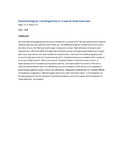| dc.contributor.author | Kager, P. A | |
| dc.contributor.author | Rees, P. H | |
| dc.date.accessioned | 2013-06-10T07:05:31Z | |
| dc.date.available | 2013-06-10T07:05:31Z | |
| dc.date.issued | 1986 | |
| dc.identifier.citation | Trop Geogr Med. 1986 Dec;38(4):371-9. | en |
| dc.identifier.uri | http://hinari-gw.who.int/whalecomwww.ncbi.nlm.nih.gov/whalecom0/pubmed/3810841 | |
| dc.identifier.uri | http://erepository.uonbi.ac.ke:8080/xmlui/handle/123456789/30405 | |
| dc.description.abstract | Various haematological parameters were followed in a group of 47 Kenyan patients with visceral leishmaniasis during treatment and follow up. The WBC and platelet numbers were normal by the time of cure, the Hb level took longer to become normal. Red cells were microcytic and hypochromic. MCV and MCH increased during follow up but microcytosis persisted up to a year after cure. Low serum iron and transferrin concentration, low total iron binding capacity and normal to high serum ferritin levels were found in 10 patients and are consistent with 'anaemia of chronic inflammation'. Bone marrows of 15 patients before treatment were normo- to hypercellular with increased erythropoietic activity. Low haemosiderin content of the bone marrow was consistent with iron deficiency, but normalization of Hb without iron suppletion would argue against a major role of iron deficiency. Coagulation studies did not indicate diffuse intravascular coagulation. Splenomegaly seems the most important factor in the causation of the pancytopenia. Further studies of contributing factors and of the cause and mechanism of 'hypersplenism' are needed. | en |
| dc.language.iso | en | en |
| dc.title | Haematological investigations in visceral leishmaniasis | en |
| dc.type | Article | en |

